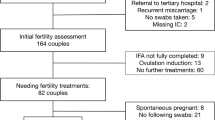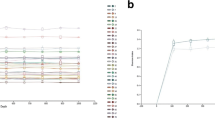Abstract
Purpose
To determine the vaginal microbiome in women undergoing IVF-ET and investigate correlations with clinical outcomes.
Methods
Thirty patients had blood drawn for estradiol (E2) and progesterone (P4) at four time points during the IVF-ET cycle and at 4–6 weeks of gestation, if pregnant. Vaginal swabs were obtained in different hormonal milieu, and the vaginal microbiome determined by deep sequencing of the 16S ribosomal RNA gene.
Results
The vaginal microbiome underwent a transition during therapy in some but not all patients. Novel bacteria were found in 33% of women tested during the treatment cycle, but not at 6–8 weeks of gestation. Diversity of species varied across different hormonal milieu, and on the day of embryo transfer correlated with outcome (live birth/no live birth). The species diversity index distinguished women who had a live birth from those who did not.
Conclusions
This metagenomics approach has enabled discovery of novel, previously unidentified bacterial species in the human vagina in different hormonal milieu and supports a shift in the vaginal microbiome during IVF-ET therapy using standard protocols. Furthermore, the data suggest that the vaginal microbiome on the day of embryo transfer affects pregnancy outcome.


Similar content being viewed by others
Abbreviations
- AP:
-
Antagonist Protocol
- B:
-
At baseline
- DH:
-
Demi-Halt Protocol
- E2 :
-
Estradiol
- GE:
-
After 6-to-8 weeks of gestation
- GnRH:
-
Gonadotropin-releasing hormone
- hCG:
-
Human chorionic gonadotropin
- IRB:
-
Institutional Review Board
- IVF-ET:
-
In vitro fertilization-embryo transfer
- LF:
-
At late follicular stage
- LLP:
-
Long Luteal Protocol
- MFP:
-
Microflare Protocol
- P4 :
-
Progesterone
- PCA:
-
Principal Component Analysis
- RDP:
-
Ribosomal Database Project
- rDNA:
-
The 16S ribosomal RNA gene
- SDI:
-
Shannon Diversity Index
- SGTC:
-
Stanford Genome Technology Center
- TR:
-
At embryo transfer
- UCSF:
-
University of California San Francisco
- VLDL:
-
Very Low Dose leuprolide acetate Protocol
References
Bezirtzoglou E, Voidarou Ch, Papadaki A, Tsiotsias A, Kotsovolou O, et al. Hormone therapy alters the composition of the vaginal flora in ovariectomized rats. Microb Ecol. 2008;55:751–9.
Schloss PD, Handelsman J. Status of the microbial census. Microbiol Mol Biol Rev. 2004;68:686–91.
Hyman RW, Fukushima M, Diamond L, Kumm J, Giudice LC, Davis RW. Microbes on the Human Vaginal Epithelium. Proc Natl Acad Sci USA. 2005;102:7952–7.
Selman H, Mariani M, Barnocchi N, Mencacci A, Bistoni F, et al. Examination of bacterial contamination at the time of embryo transfer and its impact on the IVF/pregnancy outcome. J Assist Reprod Genet. 2007;24:395–9.
Hyman RW, Jiang H, Fukushima M, Davis RW. A direct comparison of the KB Basecaller and phred for identifying the bases from DNA sequencing using chain termination chemistry. BMC Research Notes. 2010;3:257.
Cole JR, Wang Q, Cardenas E, Fish J, Chai B, Farris RJ, Kulam-Syed-Mohideen AS, McGarrell DM, Marsh T, Garrity GM, Tiedje JM. The Ribosomal Database Project: improved alignments and new tools for rRNA analysis. Nucleic Acids Res. 2009;37:D141–5. Database issue.
Wayne LG, Brenner DJ, Colwell RR, Grimont PAD, Kandler O, et al. Report of the ad-hoc-committee on reconciliation of approaches to bacterial systematics. Int J Syst Bacteriol. 1987;37:463–4.
Pace NR. A molecular view of microbial diversity and the biosphere. Science. 1997;276:734–40.
Stackebrandt E, Frederiksen W, Garrity GM, Grimont PA, Kämpfer P. Report of the ad hoc committee for the re-evaluation of the species definition in bacteriology. Int J Syst Evol Microbiol. 2002;52(3):1043–7.
Caporaso JG, Kucynski J, Stombaugh J, Bittner K, Bushman FD, Costello EK, Fierer N, Pena AG, Goodrich JK, Gordon JI, Huttley GA, Kelley ST, Knights D, Koenig JE, Ley RE, Lozupone CA, McDonald D, Muegge BD, Pirrung M, Reeder J, Sevinsky JR, Turnbaugh PJ, Walters WA, Widman J, Yatsunenko T, Zaneveld J, Knight R. QIIME allows analysis of high-throughput community sequencing data. Nat Methods. 2010;7:335–6.
Lozupone C, Lladser ME, Knights D, Stombaugh J, Knight R. UniFrac: an effective distance metric for microbial community comparison. ISME J. 2011;5:169–72.
Roseboom TJ, Vermeiden JPW, Schoute E, Lens JW, Schats R. The probability of pregnancy after embryo transfer is affected by the age of the patient, cause of infertility, number of embryos transferred and the average morphology score, as revealed by multiple logistic regression analysis. Hum Reprod. 1995;10:3035–41.
Shannon CE. A mathematical theory of communication. Bell System Technical Journal. 1948;27:379–423. 623–656.
Hughes JB, Hellmann JJ, Ricketts TH, Bohannan BJM. Counting the Uncountable: Statistical Approaches to Estimating Microbial Diversity. Appl Environ Micro. 2001;67:4399–406.
Fredricks DN, Fiedler TL, Marrazzo JM. Molecular identification of bacteria associated with bacterial vaginosis. N Engl J Med. 2005;353:1899–911.
Oakley BB, Fiedler TL, Marrazzo JM, Fredricks DN. Diversity of human vaginal bacterial communities and associations with clinically defined bacterial vaginosis. Appl Environ Microbiol. 2008;74:4898–909.
Ravel J, Gajer P, Abdo Z, Schneider GM, Koenig SS, McCulle SL, Karlebach S, Gorle R, Russell J, Tacket CO, Brotman RM, Davis CC, Ault K, Peralta L, Forney LJ. Vaginal microbiome of reproductive-age women. Proc Natl Acad Sci U S A. 2011;108 Suppl 1:4680–7.
Forney LJ, Gajer P, Williams CJ, Schneider GM, Koenig SS, et al. Comparison of self-collected and physician-collected vaginal swabs for microbiome analysis. J Clin Microbiol. 2010;48:1741–8.
Jakobsson T, Forsum U. Changes in the predominant human Lactobacillus flora during in vitro fertilisation. Ann Clin Microbiol Antimicrob. 2008;7:14–21.
Witkin SS, Kligman II, Grifo JA, Rosenwaks Z. Chlamydia trachomatis detected by polymerase chain reaction in cervices of culture-negative women correlates with adverse in vitro fertilization outcome. J Infect Dis. 1995;17:1657–659.
Liversedge NH, Turner A, Horner PJ, Keay SD, Jenkins JM, et al. The influence of bacterial vaginosis on in vitro fertilization and embryo implantation during assisted reproduction treatment. Hum Reprod. 1999;14:2411–5.
Egbase PE, Al-Sharhan M, Al-Othman S, Al-Mutawa M, Udo EE, et al. Incidence of microbial growth from the tip of the embryo transfer catheter after embryo transfer in relation to the clinical pregnancy rate following in vitro fertilization and embryo transfer. Hum Reprod. 1996;11:1687–9.
Egbase PE, Udo EE, Al-Sharhan M, et al. Prophylactic antibiotics and endocervical microbial inoculation of the endometrium at embryo transfer. Lancet. 1999;354:651–2.
Fanchin R, Harmas A, Benaoudia F, Lundkvist U, Oliveness F, et al. (Microbials of the cervix assessed at the time of embryo transfer adversely affects in vitro fertilization outcome. Fertil Steril. 1998;70:866–70.
Moore DE, Soules MR, Klein NA, Fujimoto VY, Agnew KJ, et al. Bacteria in the transfer catheter tip influence the live-birth rate after in vitro fertilization. Fertil Steril. 2000;74:1118–24.
Kim YJ, Ku SY, Jee BC, Suh CS, Kim SH, Choi YM, Kim JG, Moon SY. Dynamics of early estradiol production may be associated with outcomes of in vitro fertilization. Fertil Steril. 2010;94:2866–70.
Var T, Tonguc E, Dogan M, Mollamahmutoglu L. Relationship between the oestradiol/oocyte ratio and the outcome of assisted reproductive technology cycles with gonadotropin releasing hormone agonist. Gynecol Endocrinol. 2011;27(8):558–61. Epub 2010 Jul 20. PubMed PMID: 20642381.
Acknowledgements
We thank Liza Jalalian and Shehua Shen for assistance with the measurement of the serum hormone concentrations, and Monika Trebo for posting the CEL files on the Stanford Genome Technology Center website.
This work was supported by National Human Genome Research Institute grant P01 HG000205 (RWD, LCG).
Competing interests statement
The authors declare no competing financial interests.
Author information
Authors and Affiliations
Corresponding author
Additional information
Author contributions
RWH and LCG designed the experiments and wrote this manuscript. CNH developed the clinical database of IVF-ET patients and coordinated running the hormone assays. HJ performed several of the statistical analyses. CP applied UniFrac to the data and undertook the QIIME analyses. MF carried out the sequencing reactions, processed and assembled the sequence reads, and compared the consensus sequences to the data in the RDP. MF and RWH hand edited the contigs. KCV and DB identified appropriate patients, screened and enrolled patients, facilitated UCSF IRB compliance and sample collection, and transfer to the SGTC. ZZ measured the hormone concentrations. RWD provided the intellectual, physical, and financial milieu for the experiments at the SGTC.
Capsule
Metagenomics was used to determine the vaginal microbiome in IVF-ET cycles. Diversity of species varied in different hormonal milieu and on the day of embryo transfer correlated with outcome (live birth/no live birth). The species diversity index distinguished women who had a live birth from those who did not.
Rights and permissions
About this article
Cite this article
Hyman, R.W., Herndon, C.N., Jiang, H. et al. The dynamics of the vaginal microbiome during infertility therapy with in vitro fertilization-embryo transfer. J Assist Reprod Genet 29, 105–115 (2012). https://doi.org/10.1007/s10815-011-9694-6
Received:
Accepted:
Published:
Issue Date:
DOI: https://doi.org/10.1007/s10815-011-9694-6




